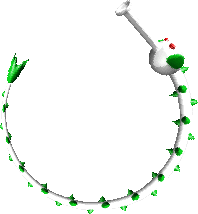Snorkel Snake
The Snorkel Snake[1][2], also called "Snorkle Fish"[3], is an enemy that appears in Yoshi's Story. It resembles a large, white serpentine creature with green spikes and a large fin for a tail. Its head is a large ball with red eyes, flippers, and a spout for a mouth. While identified as a snake in English and an eel in Japanese, it more closely resembles a giant pipefish, particularly due to the mouth.
The Snorkel Snake can be seen swimming on the world map of the Ocean, and is found in a single area of the level Lots O'Jelly Fish, where it waits for the Yoshi to swim nearby. When it spots them, it will swim in circles around them, attempting to enclose them within its spiky body; since Yoshis cannot throw eggs underwater, the Snorkel Snake is effectively invincible. However, its body is not long enough for it to make a complete circle, and the tactic is hindered even further by the snorkel being completely harmless to the Yoshis. As a result, there will always be an opening for the player to quickly swim out of.
Names in other languages
| Language | Name | Meaning |
|---|---|---|
| Japanese | ウナボン[4] Unabon |
From「鰻」(unagi, eel) and「坊」(bon, Japanese affectionate suffix for "boy") |
Trivia
- The Snorkel Snake bears a resemblance to the Dragoneel, which was introduced in New Super Mario Bros. U and also tries to encircle players with its body. The Snorkel Snake's Japanese name is used as a file name for the Dragoneel, suggesting this resemblance may have been intentional.
References
- ^ Leung, Jason, Terry Munson, and Scott Pelland. Yoshi's Story Player's Guide. Page 11.
- ^ Yoshi's Story official website (Wayback Archive). Retrieved April 23, 2015.
- ^ Yoshi's Story official website (Wayback Archive). Retrieved April 22, 2015.
- ^ 「ヨッシーストーリー 任天堂公式ガイドブック」 (Yoshi's Story Nintendo Kōshiki Guidebook), page 6.
